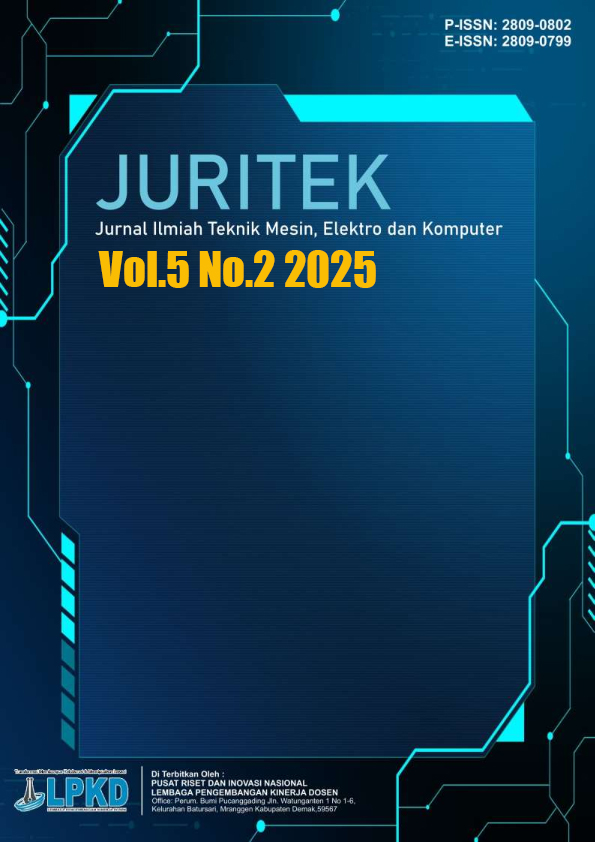Implementasi Kontrol PID untuk Sistem Steering Swerve Drive Menggunakan Motor DC dan Sensor Magnetik AS5600
DOI:
https://doi.org/10.51903/juritek.v5i2.4944Keywords:
AS5600 sensor, DC motor, PID control, STM32, swerve drive, trial-and-error tuning, wheel orientationAbstract
Swerve drive is a type of omnidirectional robot drive system that allows each wheel to rotate independently, enabling high maneuverability and precision, especially in confined or complex environments. This research focuses on the steering control of a swerve drive using a PID (Proportional-Integral-Derivative) controller applied to a DC motor with magnetic encoder feedback. The main challenge lies in achieving stable and accurate wheel orientation in response to target angles, despite potential mechanical backlash and external disturbances. The objective of this study is to design and implement a closed-loop PID control system capable of minimizing steady-state error, overshoot, and response time. The proposed method involves real-time angle control using an STM32 microcontroller, AS5600 magnetic encoder, and BTS7960 motor driver, with PID parameters tuned through trial-and-error. Experimental results were analyzed by recording transient response data via serial communication and visualizing them with Python and Matplotlib. The best PID parameters (Kp = 30, Ki = 0, Kd = 1300) yielded a delay time of 110 ms, rise time of 110 ms, peak time of 200 ms, settling time of 240 ms, and minimal overshoot (2.69%) without steady-state error. Mechanical analysis further confirmed effective torque and gear ratio utilization. The findings demonstrate that the implemented PID control system ensures accurate and stable steering angle regulation under real-time conditions. This research concludes that PID control with careful tuning is effective for swerve drive steering.
References
[1] E. H. Binugroho, A. Setiawan, Y. Sadewa, P. H. Amrulloh, K. Paramasastra, and R. W. Sudibyo, “Position and Orientation Control of Three Wheels Swerve Drive Mobile Robot Platform,” in 2021 International Electronics Symposium (IES), IEEE, Sep. 2021, pp. 669–674. doi: 10.1109/IES53407.2021.9593947.
[2] M. Haniff, H. M. Saputra, E. A. Zaki Hamidi, C. H. A. H. B. Baskoro, and S. A. Pratama, “Design and Control of Swerve Drive Mechanism for Autonomous Mobile Robot,” in 2022 16th International Conference on Telecommunication Systems, Services, and Applications (TSSA), IEEE, Oct. 2022, pp. 1–6. doi: 10.1109/TSSA56819.2022.10063871.
[3] B. DeNoma, M. Kendall, N. Poulos, J. Dong, and R. Frank, “Four-Wheel Independent Steering Swerve Drive for First Robotics Competition,” in Volume 5: Dynamics, Vibration, and Control, American Society of Mechanical Engineers, Oct. 2022. doi: 10.1115/IMECE2022-96192.
[4] K. M. Raza, M. Kamil, and P. Kumar, “IJARCCE ‘Speed Control of DC Motor by using PWM,’” International Journal of Advanced Research in Computer and Communication Engineering, vol. 5, 2016, doi: 10.17148/IJARCCE.2016.5478.
[5] H. Ying, W. Siler, and J. J. Buckley, “Fuzzy control theory: A nonlinear case,” Automatica, vol. 26, no. 3, pp. 513–520, May 1990, doi: 10.1016/0005-1098(90)90022-A.
[6] S. J. Qin and T. A. Badgwell, “AN OVERVIEW OF INDUSTRIAL MODEL PREDICTIVE CONTROL TECHNOLOGY.”
[7] M. A. Johnson et al., PID control: New identification and design methods. Springer London, 2005. doi: 10.1007/1-84628-148-2.
[8] R. P. Borase, D. K. Maghade, S. Y. Sondkar, and S. N. Pawar, “A review of PID control, tuning methods and applications,” Jun. 2021, Springer Science and Business Media Deutschland GmbH. doi: 10.1007/s40435-020-00665-4.
[9] S. J. Hammoodi, K. S. Flayyih, and A. R. Hamad, “Design and implementation speed control system of DC motor based on PID control and matlab simulink,” International Journal of Power Electronics and Drive Systems, vol. 11, no. 1, pp. 127–134, Mar. 2020, doi: 10.11591/ijpeds.v11.i1.pp127-134.
[10] S. Tang and Y. Yu, “Research on Closed-loop Control of Step Motor Based on Magnetic Encoder,” 2022.
[11] B. Zhou and J. Zhang, “Design of DC Motor PID Control System Based on STM32 Single Chip Microcomputer,” International Core Journal of Engineering, doi: 10.6919/ICJE.202007_6(7).0008.
[12] R. Rojas and A. G. Förster, “Holonomic Control of a robot with an omni-directional drive,” BöttcherIT Verlag, 2006.
[13] E. Maulana, M. A. Muslim, and A. Zainuri, “Inverse kinematics of a two-wheeled differential drive an autonomous mobile robot,” in Proceedings - 2014 Electrical Power, Electronics, Communications, Control and Informatics Seminar, EECCIS 2014. In conjunction with the 1st Joint Conference UB-UTHM , Institute of Electrical and Electronics Engineers Inc., Jan. 2014, pp. 93–98. doi: 10.1109/EECCIS.2014.7003726.
[14] H. B. Shin and J. G. Park, “Anti-windup PID controller with integral state predictor for variable-speed motor drives,” IEEE Transactions on Industrial Electronics, vol. 59, pp. 1509–1516, Mar. 2012, doi: 10.1109/TIE.2011.2163911.
[15] V. V. Patel, “Ziegler-Nichols Tuning Method: Understanding the PID Controller,” Resonance, vol. 25, pp. 1385–1397, Oct. 2020, doi: 10.1007/s12045-020-1058-z.
[16] K. Sekarsari and T. Tata, “Performance analysis of PID control in DC Brushless motor using trial and error method,” IOP Conf Ser Mater Sci Eng, vol. 1098, p. 042027, Mar. 2021, doi: 10.1088/1757-899x/1098/4/042027.
[17] X. Zhang and S. H. HosseinNia, “Transient Response Analysis of Reset PID Control Systems,” in IFAC-PapersOnLine, Elsevier B.V., Jun. 2024, pp. 430–435. doi: 10.1016/j.ifacol.2024.08.100.
Downloads
Published
How to Cite
Issue
Section
License
Copyright (c) 2025 Jurnal Ilmiah Teknik Mesin, Elektro dan Komputer

This work is licensed under a Creative Commons Attribution-ShareAlike 4.0 International License.



.png)




